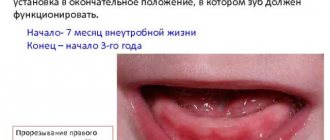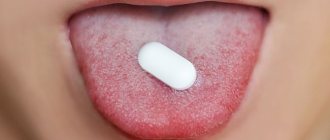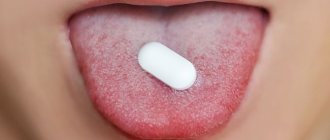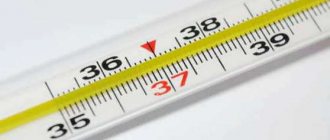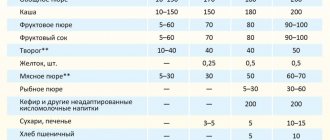Teething is an important event in the life of every child, because he will finally be able to taste solid food. However, the appearance of baby teeth is not always associated with joy and the arrival of the Tooth Fairy. Many children can become irritable and apathetic during the teething period. For some, vomiting, diarrhea, or fever occur when teeth appear.
Whether vomiting is actually caused by teething is controversial. There are no studies confirming the relationship between these natural processes. Most experts agree that teething may cause local pain, but not discomfort in other parts of the body such as rashes or diarrhea.
Other teething symptoms
Some children experience teething without any pain or discomfort. Others may exhibit specific symptoms:
- increased desire to chew;
- salivation;
- cry;
- irritability;
- inability to sleep;
- loss of appetite
- red, tender and swollen gums.
Parents’ concern for the baby’s condition is understandable, because they want to know exactly why the baby’s mood suddenly deteriorated or he began to be capricious.
According to the American Academy of Pediatrics, none of the following symptoms predict the onset of teething:
- cough;
- disturbed sleep;
- decreased appetite;
- vomit;
- diarrhea;
- rash;
- heat.
Belching - the mechanism of the process
Belching in a baby activates the process of digesting food.
Belching is a physiological process in which excess air is expelled from the stomach through the oral cavity. This requires a reflex contraction of the gastric muscles and an open cardiac sphincter. A person becomes familiar with this phenomenon in infancy.
During feeding, the baby swallows some air. It needs to be removed from their little tummy. But a small amount of air is necessary for the normal functioning of the gastrointestinal tract. This helps regulate internal pressure in the body. Additional functions of burping:
- Improving gastric motility
- Activates the process of food digestion
- Reduced pressure in the stomach
- A safe mechanism that prevents stretching of the walls of the stomach and intestines
During normal functioning of the gastrointestinal tract, the process of removing air goes unnoticed. But in pathological processes, additional symptoms are added to belching. In this case, additional examination and treatment of the underlying disease is required.
Why does a baby vomit when teething?
Teething is often wrongly blamed for many symptoms. However, research shows that cough, congestion, vomiting, diarrhea, rashes, fever (over 38°C) and sleep-wake problems are not symptoms of teething. In addition, scientists have found that no single set of symptoms can accurately signal the onset of teething.
The American Academy of Pediatrics explains that from the age of 6 months, a child's immune system weakens, losing maternal antibodies, which increases the risk of exposure to a wide range of diseases, including viruses and bacteria. This is why vomiting may have another cause, but not teething.
Belching in toddlers, which provokes a reaction
Belching occurs due to swallowing air while eating.
The normal amount of regurgitation in a toddler is 10 to 15 times a day. A larger number indicates the development of a pathological process. Additional factors that provoke belching:
- Increased activity during feeding or after eating.
- Tight swaddling, rompers or panties.
- Binge eating.
- Violation of feeding technique.
- Aerophagia is the swallowing of air while eating.
- Wrong combination when introducing complementary foods. For example, fruit puree after a cutlet.
- Dad or mom are smokers. The toddler inhales nicotine vapor. This helps weaken the stomach and sphincter muscles.
How to relieve teething discomfort?
To relieve gum discomfort, you can try massaging or rubbing them with your fingers, or giving your baby a chilled teething ring. If your baby is already chewing, you can offer him raw fruits and vegetables.
Do not give your child painkillers or gum rubs, such as viscous lidocaine or benzocaine. These medications may be harmful if swallowed. The US Food and Drug Administration opposes the use of these drugs due to the risk of overdose.
Overdose symptoms include:
- nervousness;
- confusion;
- vomiting;
- convulsions.
Probable Causes
Food intoxication can lead to pathological belching.
Doctors identify several probable causes for the development of pathological belching. All diseases require the attention of a doctor and careful treatment. Belching as a sign of disease:
- Hydrocephalus is the accumulation of fluid in the structures of the brain. It can be congenital or acquired. The first is a consequence of some viral diseases suffered by the mother while waiting for the toddler. The second is a consequence of a difficult birth, head injury, meningitis at an early age.
- Perinatal encephalopathy is a pathological process in the brain of a toddler that develops in 1 month of life. There can be a lot of reasons. These include maternal illnesses, unfavorable working conditions, stress, infections, childbirth before the age of 18, Rhesus conflict, and pathological childbirth. Each case is individual.
- Achalasia is a disorder of motor activity of the esophagus. Although this disorder belongs to gastrointestinal diseases, it is, in fact, a neurological disorder. The reasons for the development of this pathology are unknown.
- Pyloric stenosis is a congenital pathology of the pylorus of the stomach. Boys get sick more often than girls. Acquired forms are extremely rare as a result of a previous stomach ulcer. Doctors identify the following possible causes of the disease: the effect of certain medications, exposure to toxic reagents in early pregnancy, and endocrinological disorders. The result may be intestinal obstruction.
- Food intoxication.
- Infectious diseases.
- In rare cases of kidney disease.
All these pathological conditions require the attention of a doctor. Self-treatment in this case is not only inappropriate, but also dangerous. In difficult cases, surgery will be required. But only after consultation with a gastroenterologist, surgeon and based on the results of a thorough study.
Parents! Don't panic! Surgical actions for pyloric stenosis and achalasia are carried out according to methods proven over the years. Usually it is allowed to start feeding a toddler already on the 1st day after the intervention. In order to reduce the risk of developing pathologies, the expectant mother should undergo all the necessary tests and behave according to the recommendations of the gynecologist. If additional symptoms appear, do not self-medicate. Show your little one to the doctor! It's better to be safe than to bite your elbows later!
When to see a doctor
Teething can usually be managed at home. However, if a child has a high fever and symptoms not related to teeth, this is a reason to consult a doctor.
Some symptoms, such as vomiting, should not be attributed to teething because they may have a more serious underlying cause. Your doctor may want to run some tests to rule out other health problems.
On the Vikids platform you can:
Tips for parents
Let's figure out how to avoid possible dangers associated with regurgitation. The main thing that responsible parents need to know is that most often children burp while lying down. This position is dangerous due to aspiration (inhalation) of gastric contents.
Preventing aspiration is simple - just bring the baby upright or turn him on his side or stomach immediately after he burps. Then the baby will be able to push food out of his mouth.
It is worth remembering that it is unacceptable to leave a child with regurgitation syndrome without adult supervision, especially when lying on his back.
The order of changing baby teeth in children by age
After the age of 3 years, parents can take a little break from the changes. And then, at about 5 years of age, the baby teeth are replaced by permanent teeth. The process begins with the lower incisors. Then, after about a year, chewing “sixes” are cut, which parents may mistakenly mistake for milk ones. After another year, the upper incisors are replaced.
To go through this journey with your child without problems and pain, visit the dentist regularly. Children may experience pain simply from jaw expansion. Your doctor can easily tell you the cause of the discomfort. The age of 6–7 years shows the prospect of bite formation. Here you can quickly correct problems that arise so that by adolescence your child has a smooth, beautiful smile.
Next, the procedure for replacing baby teeth continues with the upper lateral incisors by the age of 8 years. At the age of 9–10 years, the molar first premolars appear, followed by the second premolars a year later. 12–13 years is the age when canines appear, and at 14 years the last second molars are cut.
The procedure for replacing baby teeth ends with the complete formation of a bite of 24 teeth.
Treatment
Treatment is required if respiratory complications occur or if irritation of the esophageal mucosa is suspected. In this case, the specialist will prescribe medications that reduce the acidity of gastric contents. This will not help with regurgitation, but will prevent further trauma to the esophagus. Specific medications are selected individually at an appointment with a pediatrician.
If the cause of regurgitation is an anatomical defect, surgical treatment may be required. Indications for surgery and its scope are specified by the surgeon.
For advice on infant feeding, please contact the specialists at the CELT clinic. Extensive experience, highly qualified clinic doctors and modern equipment are the key to the health and successful development of your children.
Make an appointment through the application or by calling +7 +7 We work every day:
- Monday—Friday: 8.00—20.00
- Saturday: 8.00–18.00
- Sunday is a day off
The nearest metro and MCC stations to the clinic:
- Highway of Enthusiasts or Perovo
- Partisan
- Enthusiast Highway
Driving directions



